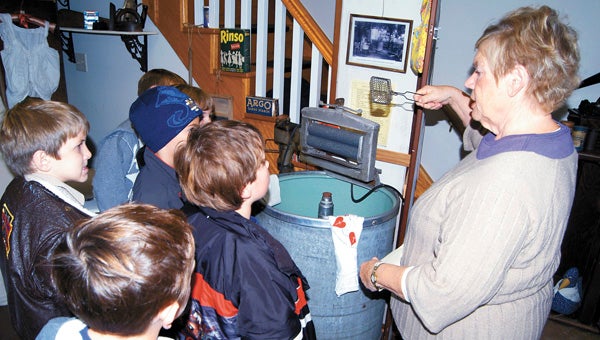Students learn about local history

Students from Eagle Lake School learn about history, including how clothes used to be washed at the Edwardsburg Museum. (Leader photo/JOHN EBY)
Edwardsburg Museum didn’t have to dip deep into history to expose second graders to bygone times.
For every photo of U.S. 12 as a dirt road, ordinary everyday items are revelatory to elementary students.
Clothespins for hanging wet wash on the line to dry.
Push lawn mowers. Rotary telephones. Typewriters.
Making soap from tallow and lye from wood ash for the laundry tub with the wringer, which could cause arm injuries.
Cooking dinner on a Round Oak stove made in Dowagiac.
Children learned people wore red flannel long johns because there was no heat in the house, with a flap for frosty outhouse seats.
A hundred years ago youngsters felt lucky — honored — to be in school because education was not compulsory for every girl and boy, dipping a turkey feather quill pen into an inkwell to write.
Edwardsburg’s district map looked like measles with red dots denoting one-room schoolhouses, including one across from the golf course in Adamsville which still exists.
One-room schools could be about the size of a one-car garage.
The concept of walking to class is lost on second graders who ride buses or are dropped off by parents.
Their best guess is that “horses and carriages” or bikes delivered pupils.
Students walked a couple of blocks or a couple of miles.
“It would be like you having to walk from Eagle Lake School up to the museum, and they did that every day,” a museum volunteer explained. “When they got there, they’d be in class with their brothers and sisters about the same age. They didn’t have kindergarten back then, so they’d be from first grade to sixth or eighth grade, depending on the school. The teacher had to teach all subjects. Back then they called them the ’three R’s’ — reading, writing and ’rithmetic. You call it math.”
Students thumbed through an old arithmetic textbook devoid of pictures or bright-colored graphics.
Teachers chopped firewood and banked fires in the pot-bellied stove, helped by older boys.
Students carried fruit, hard-boiled eggs, a sandwich or even raw potatoes to toast by the stove in lunch pails — so-called because they literally looked like sawed-off, lidded silver ice buckets.
The museum’s Round Oak stove, almost 70 years old, went from the factory to Reneberg Hardware in Cassopolis, where it sold in 1944 for $257.25.
The stove is like two-in-one. One side accommodates wood, the other coal, of which students got to examine a lump, along with kitchen appliances such as waffle irons and toasters.


